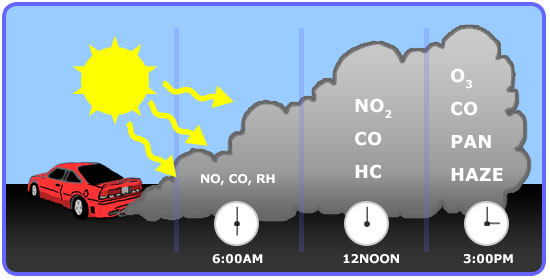Automobiles And The Environment: Understanding The Impact Of Exhaust And Photochemical Smog
Introduction
The automobile, a symbol of modern civilisation, has altered our living, working and travelling patterns. It was introduced in the early twentieth century and signalled technological progress. It changed urban landscapes worldwide. After World War II, automobile use increased rapidly. Urban expansion and increased vehicle density revealed hidden environmental costs. This article examines measured vehicle exhaust impacts with a focus on photochemical smog.
Sources of Vehicular Pollution
Vehicle pollution primarily originates from exhaust emissions. In urban areas, vehicles emit white or black smoke that contributes to air and noise pollution. When one tonne of petrol is combusted, between 10 and 70 kg of exhaust gases are produced. These gases contain between 150 and 200 different compounds. In addition, approximately 20 to 40 kg of petrol and gas may escape from fuel and combustion systems. These emissions include carbon monoxide, nitrogen oxides, lead dust and soot. Their release reduces air quality and poses health risks. Regulatory measures and technical modifications are needed accordingly.

Understanding Photochemical Smog
Photochemical smog forms when nitrogen oxides react under strong sunlight. The nitrogen oxides undergo photochemical reactions that produce free oxygen atoms. These atoms combine with standard oxygen molecules to form ozone. Ground-level ozone is a harmful pollutant. It reacts with vehicle hydrocarbons and produces compounds such as formaldehyde, acetaldehyde and various ketones. This chemical conversion reduces atmospheric clarity and causes health risks.
Photochemical smog formation is a dynamic process. Weather conditions and urban topography can retain smog over a city. This retention extends exposure duration. Understanding these chemical processes supports the development of strategies to reduce smog levels. Such strategies include improving fuel quality, tightening vehicle emission standards and promoting alternative transport.
Impacts of Photochemical Smog
Photochemical smog affects human health and the environment. It has been linked to increases in respiratory and cardiovascular conditions. Documented urban episodes include those in Los Angeles. Evidence includes discolouration of suburban vegetation and tree mortality, notably of pines and evergreens. Photochemical smog also affects domestic animals, degrades rubber products and accelerates corrosion of buildings and monuments.
Health experts have recorded that prolonged exposure to photochemical smog exacerbates asthma, contributes to chronic bronchitis and reduces lung function. This exposure lowers quality of life and increases healthcare expenditure. It also reduces labour productivity and agricultural yields. Measured impacts on crop production and natural habitats support the need for improved air quality management and pollution reduction measures.
Other Pollutant Emissions and Environmental Concerns
In addition to photochemical smog, vehicles emit other toxic substances. These include sulphur dioxide, carbon monoxide and lead compounds. These substances directly affect human health. Noise, vibrations and dust from vehicles also contribute to urban pollution. Such factors affect residents’ mental and physical health. Stricter emission standards and changes in urban planning are required. Public transport and non-motorised travel options, such as cycling and walking, must be promoted accordingly.
Conclusion
Motor vehicles remain essential in modern society and have improved mobility. They also create significant environmental challenges. The dual effects of automobiles require a reassessment of vehicle technology and urban planning. Future improvements in vehicle design, fuel efficiency and public transport are necessary to reduce vehicle emissions. A shift to electric vehicles and renewable energy sources may reduce the ecological footprint of transportation. Expanding public transport and increasing non-motorised travel, for example cycling and walking, could lower urban air pollution. These measures support long-term urban sustainability and result in healthier living conditions for future generations.

 Bars
Bars
 Beads & Spheres
Beads & Spheres
 Bolts & Nuts
Bolts & Nuts
 Crucibles
Crucibles
 Discs
Discs
 Fibers & Fabrics
Fibers & Fabrics
 Films
Films
 Flake
Flake
 Foams
Foams
 Foil
Foil
 Granules
Granules
 Honeycombs
Honeycombs
 Ink
Ink
 Laminate
Laminate
 Lumps
Lumps
 Meshes
Meshes
 Metallised Film
Metallised Film
 Plate
Plate
 Powders
Powders
 Rod
Rod
 Sheets
Sheets
 Single Crystals
Single Crystals
 Sputtering Target
Sputtering Target
 Tubes
Tubes
 Washer
Washer
 Wires
Wires
 Converters & Calculators
Converters & Calculators
 Write for Us
Write for Us



 Chin Trento
Chin Trento



